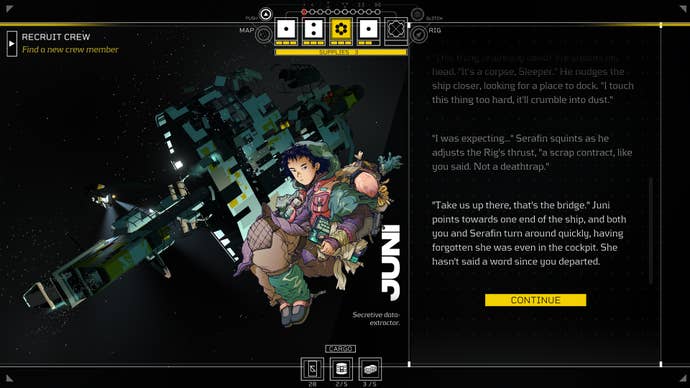Citizen Sleeper 2: Starward Vector is radically different to the first game, but even this early on, it's doing everything I want a deep, dense RPG to do - preview
Jump Over the Age's follow-up to one of 2022's best RPGs is off to a promising start.
Time doesn't sit still in the world of Citizen Sleeper. It's a big theme in the first game, really making you aware of the time you do (and sometimes don't) have. Each decision needs to be thought through, as time wasted could cost you. But spending your hours well can also bring a lot of joy and comfort. With its upcoming sequel, Citizen Sleeper 2: Starward Vector, I was very much hoping that these ideas would carry through, and having spent a bit of time with the game in a recent hands-on preview, I'm happy to say it does. Albeit in entirely new, and sometimes surprising, ways.
For those unfamiliar with the first one, Citizen Sleeper is a tabletop-inspired RPG set in a sci-fi world where you play as an android, known as a "Sleeper", whose consciousness is copied from a real person, all for the purpose of working for a corporation. You spend your days working odd jobs, meeting new people, forming relationships, all while you try to stop your body from failing due to its reliance on something known as 'stabiliser'. Activities can be accomplished by using dice rolls, with stats modifying how successful you are likely (or unlikely) to be, and if you don't manage your health well enough, you can end up with less dice to work with.
Starward Vector works similarly, once again giving you six dice to work with each cycle – though now you play as a different Sleeper, one who is also on the run from the corporation that made them, but is also hiding from a gang that wants to control them. You've managed to alter your android body so you aren't reliant on 'stabiliser', but that comes with a consequence: amnesia. Just like in any decent RPG. Luckily, your friend Serafin is there to help you, as you are to help them.
Where the first game places you on a space station called The Eye for its entire runtime, this time you have the opportunity to travel to different stations across an area known as the Starward Belt. You see, being on the run leaves you without many funds, so you have to turn to freelance work. This is where, mechanically, Starward Vector radically departs from the first game, as the jobs that you take on require you to form a crew.
Right off the bat, what I particularly love about this is the way that it encourages you to think about how you want to roleplay your sleeper. The first potential crew member you get introduced to is a suspicious young woman by the name of Juni. She claims the person that gave you your first job sent her – but he didn't tell you that, so it's up to you to decide whether you want to see what bringing her aboard might entail. These, to be clear, are very difficult decisions.

The jobs themselves are stressful, too. Just like in real life. They can be failed, which obviously has its own consequences, but stress is the name of the game here... just like in real life.
In Starward Vector, you quite literally have a stress gauge, which again affects how your dice roles will perform if it gets too high. Even worse, your crew mates have their own stress gauge. The benefit of bringing certain people on-board means that you have extra dice rolls to perform various tasks, though they're also individually limited by specific skill types, too. If their own stress gets too high, they won't be able to help you out, and you'll be down a crew mate. And the vibes on board your craft will be rancid, too.
Skills have also been reworked a bit. In the first game, given enough time you could build up any skill to a useful level, even though one particular type might start lower depending on what class you chose. Now, each class type has a skill they cannot improve at all, meaning your dice rolls will be two points lower any time you try to do something that requires that skill. This works really well in tandem with building out your crew - do you want to hire people that have skills you don't, or would you rather prioritise getting to know someone specific, even if it might lose you a contract?
These changes to Citizen Sleeper's systems do a really good job of pushing you to think about what kind of choices you want to make, and the reasons as to why you might make them. I often think that RPGs struggle to encourage this kind of play, particularly because in video games there are a select number of pre-determined paths, but lead developer Gareth Damian Martin's writing is so strong yet again, even early on in the sequel, that you won't just click on a dialogue option just for the sake of "winning". If such a thing is even possible in a game like Citizen Sleeper.
There is a whole lot left to discover in Starward Vector, I barely scratched surface of the stories that await me there, and if any of the microcosm of adventures the preview promises are even a fraction as good as the first game, I'm sure to be in for one of the best cyberpunk experiences around.
Citizen Sleeper 2: Starward Vector is planned for release in early 2025 on PS5, Nintendo Switch, PC, and Xbox.

.jpg?width=70&height=70&fit=crop&quality=60&format=png&auto=webp)
